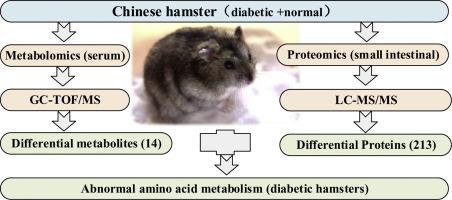当前位置:
X-MOL 学术
›
J. Proteomics
›
论文详情
Our official English website, www.x-mol.net, welcomes your feedback! (Note: you will need to create a separate account there.)
Small intestine proteomics coupled with serum metabolomics reveal disruption of amino acid metabolism in Chinese hamsters with type 2 diabetes mellitus.
Journal of Proteomics ( IF 3.3 ) Pub Date : 2020-05-16 , DOI: 10.1016/j.jprot.2020.103823 Chenyang Wang 1 , Jingjing Yu 1 , Ruihu Zhang 1 , Wentao Wang 2 , Zeya Shi 1 , Yu Liu 3 , Guohua Song 1 , Hailong Wang 2 , Naijian Han 4 , Liqun Huang 5 , Yuze An 2 , Shouyuan Tian 6 , Zhaoyang Chen 1
Journal of Proteomics ( IF 3.3 ) Pub Date : 2020-05-16 , DOI: 10.1016/j.jprot.2020.103823 Chenyang Wang 1 , Jingjing Yu 1 , Ruihu Zhang 1 , Wentao Wang 2 , Zeya Shi 1 , Yu Liu 3 , Guohua Song 1 , Hailong Wang 2 , Naijian Han 4 , Liqun Huang 5 , Yuze An 2 , Shouyuan Tian 6 , Zhaoyang Chen 1
Affiliation

|
Type 2 diabetes mellitus (T2DM) is a metabolic disorder characterized by hyperglycemia, with metabolic disturbances resulting from defects in insulin secretion, insulin resistance (IR), or both. Chinese hamsters have potential value as non-obese animal models of spontaneous T2DM for studying the pathogenesis and molecular characteristics of diabetes. In this study, the molecular characteristics of the Chinese hamster diabetes animal model were investigated through small intestine proteomics and serum metabolomics. A total of 213 differentially abundant proteins and 14 differentially abundant metabolites were identified through liquid chromatography-tandem mass spectrometry (LC-MS/MS) and gas chromatography-time of flight mass spectrometry (GC-TOF/MS) analysis, respectively. Annotation by bioinformatics analysis revealed that these differentially abundant proteins in the small intestine were commonly associated with abnormal glucose and lipid metabolism, IR, impaired insulin secretion, amino acid metabolism disorders, and inflammatory dysregulation. Moreover, differentially abundant metabolites in the serum were amino acids and were related to diabetic IR. Through the analysis of small intestine proteomics and serum metabolomics in the Chinese hamster diabetes model, we provide a preliminary understanding of the diabetic characteristics of this model from a molecular perspective. This study provides data incentivizing the popularization and application of Chinese hamsters in T2DM research. SIGNIFICANCE: Spontaneous rodent models of diabetes, such as Chinese hamsters, effectively summarizes the clinical characteristics of type 2 diabetes and has high applicative value for studying the pathophysiology of diabetes. In order to explore the potential value of the Chinese hamster diabetes animal model in the study of the T2DM molecular mechanism, we performed small intestine proteomic analysis and serum metabolomic analysis in Chinese hamsters for the first time. After an integrated analysis of proteomics and metabolomics, we have a preliminary understanding of the diabetic characteristics of this model from a molecular perspective. Further, we found that in the occurrence and development of T2DM, the metabolic abnormalities of this model are particularly prominent, especially the metabolism of amino acids. These findings not only provide basic data in support of the popularization and application of the current model in T2DM research, but also provide a new perspective for the exploration of mechanisms related to T2DM.
更新日期:2020-05-16


























 京公网安备 11010802027423号
京公网安备 11010802027423号